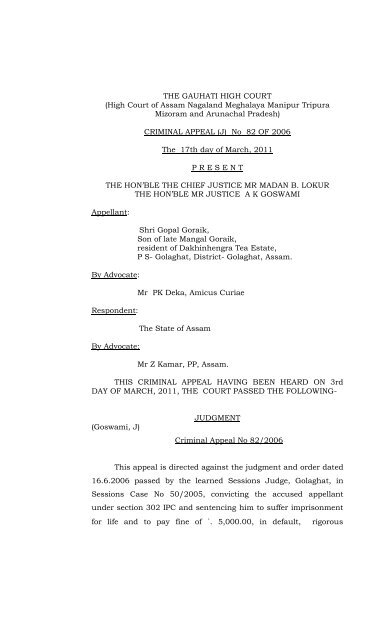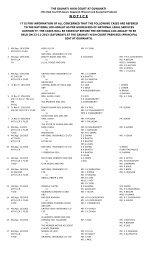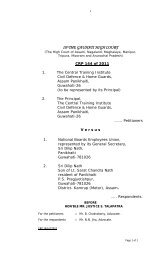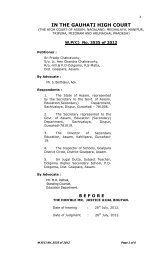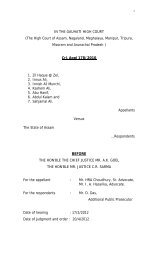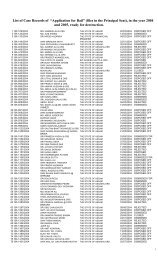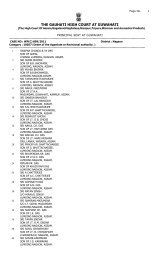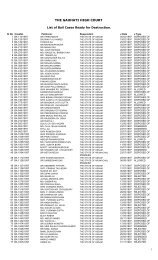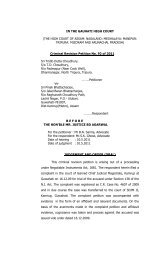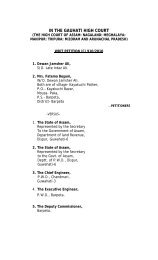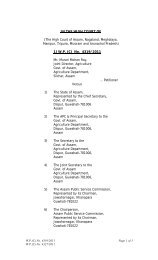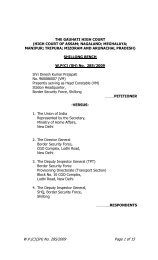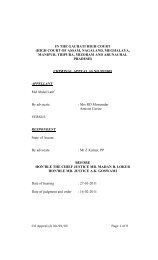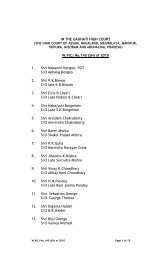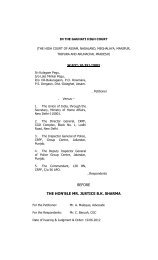CRL.A(J) - Gauhati High Court
CRL.A(J) - Gauhati High Court
CRL.A(J) - Gauhati High Court
You also want an ePaper? Increase the reach of your titles
YUMPU automatically turns print PDFs into web optimized ePapers that Google loves.
THE GAUHATI HIGH COURT<br />
(<strong>High</strong> <strong>Court</strong> of Assam Nagaland Meghalaya Manipur Tripura<br />
Mizoram and Arunachal Pradesh)<br />
CRIMINAL APPEAL (J) No 82 OF 2006<br />
The 17th day of March, 2011<br />
P R E S E N T<br />
THE HON’BLE THE CHIEF JUSTICE MR MADAN B. LOKUR<br />
THE HON’BLE MR JUSTICE A K GOSWAMI<br />
Appellant:<br />
By Advocate:<br />
Respondent:<br />
By Advocate:<br />
Shri Gopal Goraik,<br />
Son of late Mangal Goraik,<br />
resident of Dakhinhengra Tea Estate,<br />
P S- Golaghat, District- Golaghat, Assam.<br />
Mr PK Deka, Amicus Curiae<br />
The State of Assam<br />
Mr Z Kamar, PP, Assam.<br />
THIS CRIMINAL APPEAL HAVING BEEN HEARD ON 3rd<br />
DAY OF MARCH, 2011, THE COURT PASSED THE FOLLOWING-<br />
(Goswami, J)<br />
JUDGMENT<br />
Criminal Appeal No 82/2006<br />
This appeal is directed against the judgment and order dated<br />
16.6.2006 passed by the learned Sessions Judge, Golaghat, in<br />
Sessions Case No 50/2005, convicting the accused appellant<br />
under section 302 IPC and sentencing him to suffer imprisonment<br />
for life and to pay fine of `. 5,000.00, in default, rigorous
2<br />
imprisonment for one year, for committing the offence of murder by<br />
intentionally causing death of one Haren Goraik.<br />
2. We have heard Mr P K Deka, learned Amicus Curiae and Mr<br />
Z Kamar, learned PP, Assam.<br />
3. Smt. Sumitra Goraik, wife of the deceased Haren Goraik,<br />
had filed an ejahar before the Officer-in-Charge, Kamarbandha<br />
Police Station on 11/1/2005, stating therein that on 10/1/2005,<br />
at about 4:30 PM, the accused appellant, Gopal Goraik @ Bubai,<br />
hacked her husband with a “Kalam Katari” (pruning knife), at the<br />
office premises of the tea estate while he was on duty. Her<br />
husband suffered serious injuries and accordingly, he was shifted<br />
to the Golaghat Civil Hospital by the garden authorities. However,<br />
he had succumbed to his injuries at 6:30 PM on the very day. On<br />
the basis of the ejahar, Golaghat Police Station Case No 25/2005<br />
under section 302 IPC was registered.<br />
4. The investigation was started and finding sufficient materials<br />
against the accused appellant, charge sheet was submitted under<br />
section 302 IPC. As the case was exclusively triable by the <strong>Court</strong> of<br />
Sessions, the case was committed by the learned Magistrate to the<br />
<strong>Court</strong> of the learned Sessions Judge, Golaghat.<br />
5. The learned trial <strong>Court</strong> framed charge under section 302<br />
IPC. Charges having been read over to the accused appellant, he<br />
pleaded not guilty and claim to be tried.<br />
6. During the trial prosecution examined 14 witnesses. Defence<br />
adduced no evidence. PW-1, the wife, is a reported witness. PW-2,<br />
who is the president of the Labour Sangha of Dakhin Bhangra Tea<br />
Estate, where the deceased was working, also did not witness the<br />
incident. He was, however, a witness to the inquest report, Ext- 1.
3<br />
7. PW-3 is also an employee in the tea garden. He saw the<br />
deceased (then injured), when he was in the process of being<br />
shifted to a vehicle, for the purpose of taking him to Golaghat Civil<br />
Hospital. According to him, the deceased was not in a position to<br />
speak. He was also a witness to Ext-1.<br />
8. PWs-4, 5, 6, 9 and 10 claimed to be eye witnesses of<br />
incident of accused appellant hitting / cutting the deceased with a<br />
pruning knife and they gave their versions of the incident. PW 7<br />
was a reported witness and he did not contribute anything towards<br />
furthering the prosecution case.<br />
9. PW-8 is the doctor who had conducted post mortem<br />
examination on the dead body of Haren Goraik.<br />
10. PW- 11, 12 and 13 were witnesses to the seizure list, Ext- 2,<br />
by which one pruning knife stained with blood, was seized, when<br />
the same was produced by the accused from the backside of the<br />
house of PW 12.<br />
11. PW 14 is the Investigating Officer. In his deposition, he<br />
stated that the accused surrendered on 13.1.05 at about 3.00 PM<br />
and on interrogation, he had stated that he had cut one Haren<br />
Goraik with a pruning knife and had kept the weapon used in the<br />
assault in the house of PW- 12. He had also stated that the police<br />
was led by the accused appellant to the house of PW- 12 and on<br />
being asked by the accused, PW- 12 had produced the pruning<br />
knife, M. Ext-1.<br />
12. The learned trial <strong>Court</strong> relied on the evidence of PWs- 4, 5, 6,<br />
9, 10, 11, 12 and 13 as eye witnesses and took a view that the<br />
defence could not discredit their testimony. It is to be noted that<br />
PWs- 11, 12 and 13 were not eye witnesses but were witnesses to<br />
the seizure list, Ext-2. The learned trial <strong>Court</strong> also appears to have
4<br />
accepted the version of the prosecution with regard to the recovery<br />
of the M. Ext- 1, pruning knife, at the instance of the accused<br />
appellant. The learned trial <strong>Court</strong>, after examination of the accused<br />
under Section 313 CrPC, took the view that the prosecution had<br />
been able to establish the guilt of the accused appellant beyond<br />
reasonable doubt and accordingly, convicted him for committing<br />
offence of murder under section 302 IPC.<br />
13. Learned Amicus Curiae, after outlying the prosecution case,<br />
in brief, had drawn our attention to the examination of the accused<br />
under section 313 CrPC. According to him, the learned trial <strong>Court</strong><br />
without any application of mind mechanically put certain<br />
questions to the accused appellant and such questions leave a lot<br />
to be desired. He further submits that the learned trial <strong>Court</strong><br />
appeared to have been totally oblivious of the purpose for which<br />
section 313 CrPC finds place in the statute. He submits that<br />
cursory nature of examination has deprived the accused appellant<br />
the opportunity of explaining the circumstances appearing against<br />
him, warranting setting aside of the order of conviction of the<br />
accused appellant and a direction to the learned trial <strong>Court</strong> for<br />
disposal of the case afresh after examining the appellant under<br />
section 313 Code of Criminal Procedure, 1973, in accordance with<br />
law. The learned Amicus Curiae has placed reliance on the<br />
following decisions of the Apex <strong>Court</strong><br />
(1) Kuldip Singh and others Vs State of Delhi, reported in<br />
(2003) 12 SCC 528.<br />
(2) Ajay Singh Vs State of Maharastra, reported in (2007)<br />
12 SCC 341.<br />
(3) Suraj Gupta and others Vs State of Mghalaya, reported<br />
in 2010 (3) GLT 225.<br />
(4) SH Lalsangzuala Vs State of Mizoram, reported in<br />
2011 (1) GLT 47.
5<br />
14. In view of the submissions of the learned Amicus Curiae, we<br />
consider it appropriate to reproduce the examination of the<br />
accused appellant, in its entirety.<br />
“Question – Shri Naren Neog, PW - 4 deposed that on<br />
10.1.2005 on hearing hallah, he saw you<br />
are assaulting Horen Goraik with a Kalam<br />
Katari. What do you say <br />
Answer - No. I am innocent.<br />
Question –<br />
Answer -<br />
Question –<br />
PW - 4 further deposed that Shri Sonaram<br />
Bauri with a Belsa hit on your hand<br />
having Kalam Katari and one Natrat<br />
Mahmmad had also assaulted on your<br />
hand with a view to save Horen Goraik.<br />
What do you say <br />
No. I am innocent.<br />
Md Ramjan Ali, PW - 6 deposed that on<br />
10.1.2005 on your hearing hallah, he<br />
came out from the office and saw that you<br />
are assaulting Horen Goraik with a Kalam<br />
Katari and he threw a piece of brick<br />
towards you with a view to save Horen<br />
Goraik. What do you say <br />
Answer - No. I am innocent.<br />
Question –<br />
Whether you state anything about the<br />
occurrence <br />
Answer - No.<br />
Question –<br />
Whether you will adduce any evidence in<br />
your defence <br />
Answer - No.”<br />
15. We have already indicated, albeit, very briefly, the nature of<br />
the evidence appearing against the accused appellant. We are<br />
dismayed by the farcical nature of the examination of the accused<br />
appellant conducted by the learned trial <strong>Court</strong> . It gives the
6<br />
impression that the examination of the accused appellant under<br />
section 313 CrPC was an avoidable ritual and that the same has<br />
no role at all in a criminal trial. The learned trial <strong>Court</strong> discharged<br />
its responsibility by merely asking a few questions on the basis of<br />
testimony of PWs- 4 and 6 only, without adverting to other<br />
materials on record, on which the learned trial court had placed<br />
reliance.<br />
16. To appreciate the scope and purpose of Section 313 CrPC,<br />
we consider it expedient to quote the section below for ready<br />
reference:<br />
“313. Power to examine the accused. (1) In every<br />
inquiry or trial, for the purpose of enabling the accused<br />
personally to explain any circumstances appearing in the<br />
evidence against him, the <strong>Court</strong><br />
(a)<br />
may at any stage, without previously<br />
warning the accused put such questions<br />
to him as the <strong>Court</strong> considers necessary<br />
(b) shall after the witnesses for the<br />
prosecution have been examined and<br />
before he is called on for his defence<br />
question him generally on the case:<br />
Provided that in a summons-case where the <strong>Court</strong><br />
has dispensed with the personal attendance of the<br />
accused, it may also dispense with his examination under<br />
clause (b).<br />
(2) No oath shall be administered to the accused<br />
when he is examined under sub-section (1).<br />
(3) The accused shall not render himself liable to<br />
punishment by refusing to answer such question, or by<br />
giving false answers to them.<br />
(4) The answers given by the accused may be taken<br />
into consideration in such inquiry or trial, and put in<br />
evidence for or against him in any other inquiry into, or<br />
trial for, any other offence which such answers may tend<br />
to show he has committed.”.
7<br />
17. It will also be apposite to state that in the earlier Code of<br />
Criminal Procedure, 1898, power to examine an accused was<br />
found in section 342. We also extract section 342 of the earlier<br />
Code hereinbelow:<br />
342. (1) For the purpose of enabling the<br />
accused to explain any circumstances appearing in<br />
the evidence against him, the <strong>Court</strong> may, at any stage<br />
of any inquiry or trial without previously warning the<br />
accused, put such questions to him as the <strong>Court</strong><br />
considers necessary, and shall, for the purpose<br />
aforesaid, question him generally on the case after the<br />
witnesses for the prosecution have been examined and<br />
before he is called on for his defence.<br />
(2) The accused shall not render himself liable to<br />
punishment by refusing to answer such questions, or<br />
by giving false answers to them; but the <strong>Court</strong> and the<br />
jury (if any) may draw such inference from such<br />
refusal or answers as it thinks just.<br />
(3) The answers given by the accused may be<br />
taken into consideration in such inquiry or trial, and<br />
put in evidence for or against him in any other inquiry<br />
into, or trial for, any other offence which such answers<br />
may tend to show he has committed.<br />
(4) No oath shall be administered to the accused<br />
when he is examined under sub-section (1).”.<br />
18. Comparison of two sections extracted hereinabove would<br />
show that sub-section (1) of the present section 313 corresponds to<br />
section (1) of the old Code. However, sub-section has been rearranged.<br />
The word “personally” has been added after the words<br />
“accused” in the expression “ for the purpose of enabling the<br />
accused to explain any circumstance appearing in the evidence<br />
against him” and the proviso has been newly added. Sub-section<br />
(2) corresponds to sub-section (4) of the old Code. Sub-section (3)<br />
corresponds to sub-section (2) of Old Code. The provision for<br />
drawing inference for the refusal to give answer or to give false<br />
answer appearing in old sub-section (2) has been omitted in the
8<br />
present section. Sub-section (4) corresponds to sub-section (3) of<br />
the old Code.<br />
19. The basic purpose of section 313 CrPC as it stands today is<br />
to give an opportunity to the accused to “personally” explain the<br />
circumstances appearing against him in the evidence and that is<br />
why the word “personally” has now found a place in the present<br />
section 313 CrPC. This is significant because his statement can be<br />
taken into consideration in judging his innocence or guilt.<br />
20. In Tara Singh Vs State of Punjab, reported in AIR 1951 SC<br />
441, in the context of section 342 of the earlier Code, the Apex<br />
<strong>Court</strong> had stated that it cannot stress too strongly the importance<br />
of observing faithfully and fairly the provisions of section 342 of the<br />
Code and it is not sufficient compliance to string together a long<br />
series of facts and ask the accused what he had to say about them.<br />
Bearing in mind the aim and object of the section, which is to<br />
afford a fair and proper opportunity of explaining the<br />
circumstances which appeared against him, logically and<br />
rationally, the questioning must be done in such manner and in<br />
such a form which even an ignorant and illiterate person can<br />
appreciate and understand. Even otherwise, an accused would be<br />
somewhat perturbed when he is facing a charge and, therefore,<br />
fairness demands that each material fact should be put simply<br />
and separately. The Apex <strong>Court</strong> also noted that every error or<br />
omission to record the statement in that behalf would not<br />
necessarily vitiate a trial because errors of these type fall within<br />
the domain of curable irregularities. The fall out of such omission<br />
or errors in each case depends upon the degree of error and<br />
whether prejudice had been occasioned or is likely to have<br />
occasioned.<br />
21. In Kuldip Singh and others(supra), the Apex <strong>Court</strong> held<br />
that the question of establishing prejudice does not arise in view of
9<br />
the fact that the prosecution seeks to rely upon the incriminating<br />
circumstances to indicate the involvement of the accused.<br />
22. The Apex <strong>Court</strong> in Basavaraj R Patil and others Vs State of<br />
Karnataka, reported in (2000) 8 SCC 740, had discussed the aims<br />
and object of section 313 of the Code as under:<br />
“( 10 ) Dealing with the position as the Section<br />
remained in the original form under the old Code, a<br />
three Judge Bench of this <strong>Court</strong> (Fazal Ali, Mahajan<br />
and Bose, JJ.) interpreted the section in Hate Singh<br />
Bhagat Singh v. State of Madhya Bharat, AIR 1953 SC<br />
468 that<br />
"The statements of the accused recorded by<br />
committal Magistrate and the Sessions Judge are<br />
intended in India to take the place of what in England<br />
and in America he would be free to state in his own<br />
way in the witness box; they have to be received in<br />
evidence and treated as evidence and be duly<br />
considered at the trial. "<br />
………………………………………………………………<br />
………………………………………………………………………<br />
………………………………………………………………………<br />
………………………………………………………………….<br />
“( 20 ) At the same time it should be borne in mind<br />
that the provision is not intended to nail him to any<br />
position, but to comply with the most salutary<br />
principle of natural justice enshrined in the maxim<br />
"audi alteram partem". The word "may" in clause (a) of<br />
sub-section (1) in Section 313 of the Code indicates,<br />
without any doubt, that even if the court does not put<br />
any question under that clause the accused cannot<br />
raise any grievance for it. But if the court fails to put<br />
the needed question under clause (b) of the subsection<br />
it would result in a handicap to the accused<br />
and he can legitimately claim that no evidence,<br />
without affording him the opportunity to explain, can<br />
be used against him. It is now well settled that a<br />
circumstance about which the accused was not asked<br />
to explain cannot be used against him.”.<br />
23. In Ajay Singh (Supra), the Supreme <strong>Court</strong>, in paragraphs 13<br />
and 14 stated thus :
10<br />
“13. The object of examination under this section is to<br />
give the accused an opportunity to explain the case<br />
made against him. This statement can be taken into<br />
consideration in judging his innocence or guilt. Where<br />
there is an onus on the accused to discharge, it<br />
depends on the facts and circumstances of the case if<br />
such statement discharges the onus.<br />
14. The word “generally” in sub-section (1)(b) does not<br />
limit the nature of the questioning to one or more<br />
questions of a general nature relating to the case, but<br />
it means that the question should relate to the whole<br />
case generally and should also be limited to any<br />
particular part or parts of it. The question must be<br />
framed in such a way as to enable the accused to<br />
know what he is to explain, what are the<br />
circumstances which are against him and for which an<br />
explanation is needed. The whole object of the section<br />
is to afford the accused a fair and proper opportunity<br />
of explaining circumstances which appear against him<br />
and that the questions must be fair and must be<br />
couched in a form which an ignorant or illiterate<br />
person will be able to appreciate and understand. A<br />
conviction based on the accused’s failure to explain<br />
what he was never asked to explain is bad in law. The<br />
whole object of enacting Section 313 of the Code was<br />
that the attention of the accused should be drawn to<br />
the specific points in the charge and in the evidence on<br />
which the prosecution claims that the case is made<br />
out against the accused so that he may be able to give<br />
such explanation as he desires to give.<br />
24. In SH Lalsangzuala (supra) and Suraj Gupta (supra), this<br />
<strong>Court</strong>, for the failure of the learned trial <strong>Court</strong> to put<br />
incriminating evidence to the accused in his examination under<br />
section 313 CrPC, had set aside the conviction and sentence and<br />
had remanded the case to the learned trial <strong>Court</strong> for fresh<br />
consideration after examining the accused in accordance with law.<br />
25. In view of what has been stated herein above, we are of the<br />
opinion that the examination of the accused appellant under<br />
section 313 CrPC, in the facts and circumstance of the case, do<br />
not satisfy the requirement of the section. Accordingly, conviction<br />
recorded and sentence awarded are hereby quashed. The matter is
11<br />
remanded to the learned trial <strong>Court</strong> with a direction that the<br />
learned trial <strong>Court</strong> in accordance with the underlying principles of<br />
section 313 CrPC, shall put all the circumstances appearing<br />
against the accused appellant to him to enable him to explain the<br />
incriminating circumstances and provide him all opportunity to<br />
adduce evidence, if he wishes, in his defence. The learned trial<br />
<strong>Court</strong> is directed to complete the trial of the case within a period<br />
of 2 months from today. We also quash the statements of the<br />
accused appellant recorded earlier under section 313 CrPC. The<br />
learned trial <strong>Court</strong> would dispose of the case after hearing the<br />
parties.<br />
26. Before parting with the records, we make it clear that we<br />
have not made any observation touching upon the merits of the<br />
case and the broad feature of the evidence of the prosecution<br />
witnesses, as indicated in the judgment, was, only for the purpose<br />
of bringing to the fore the shortcomings of examination of the<br />
accused under Section 313 CrPC.<br />
27. In the result, the appeal is partly allowed.<br />
28. The trial <strong>Court</strong> records be sent down forthwith.<br />
gch<br />
JUDGE<br />
CHIEF JUSTICE


